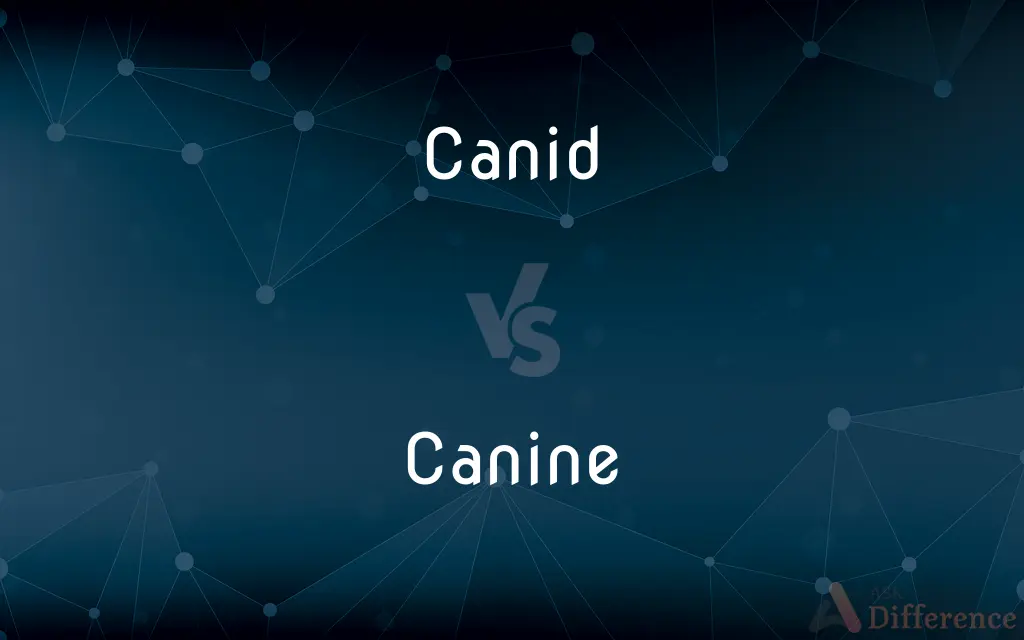Canid vs. Canine — What's the Difference?
By Maham Liaqat & Urooj Arif — Updated on March 28, 2024
Canid refers to the biological family of dogs and related species, while canine often denotes the teeth of these animals or attributes pertaining to dogs.

Difference Between Canid and Canine
Table of Contents
ADVERTISEMENT
Key Differences
Canids encompass the family Canidae, which includes dogs, wolves, foxes, and other related species. They share common characteristics such as fur, carnivorous diets, and similar social structures. Canine, on the other hand, refers to anything related to dogs, particularly their sharp, pointed teeth used for gripping and tearing flesh. While "canid" is strictly zoological, "canine" extends to dental anatomy and broader dog-related contexts.
The diversity within the canid family is significant, ranging from domestic dogs to wild species like the gray wolf and the African wild dog. This diversity is seen in their sizes, habitats, and behaviors. Canine teeth, whereas, are a specific type of tooth found not only in canids but also in other carnivorous and omnivorous mammals, highlighting their role in predation and feeding habits. While canid diversity reflects evolutionary adaptation, canine teeth underscore anatomical specialization for diet.
In terms of behavior, canids exhibit a wide range of social structures, from the solitary foxes to the highly organized packs of wolves. These behaviors reflect adaptations to various ecological niches. Canine attributes, including behaviors, extend to loyalty, protectiveness, and trainability in dogs, traits that have been selected and bred over thousands of years. This distinction illustrates the difference between a biological family's behavioral ecology and the specific traits valued in domestic dogs.
Conservation efforts for canids focus on preserving habitat and species diversity, addressing threats like habitat loss, poaching, and conflict with humans. These efforts are crucial for maintaining ecological balance and biodiversity. Canine care and management, in contrast, involve veterinary care, diet, exercise, and training for domestic dogs, emphasizing the responsibility of pet ownership and the human-animal bond. This contrast highlights the different focuses of environmental conservation versus individual animal welfare.
Research on canids provides insights into evolutionary biology, ecology, and conservation strategies, contributing to our understanding of mammalian diversity and adaptation. Canine research, focusing on dental health, behavior, and genetics of domestic dogs, has implications for veterinary medicine, animal behavior, and the pet industry. The difference in research focus underscores the broad scientific interest in canids' ecological roles and the specific applications of canine studies to improve pet care and management.
ADVERTISEMENT
Comparison Chart
Definition
A member of the family Canidae, including dogs, wolves, and foxes.
Pertaining to dogs, often specifically their pointed teeth.
Scope
Zoological, covering a range of species.
Broad, including dental anatomy, dog-related attributes, and behaviors.
Diversity
Species diversity, ecological niches.
Variability in dental structure, breeds, and dog traits.
Conservation/Management
Focus on habitat preservation and species protection.
Emphasizes pet care, health, and behavior management.
Research Focus
Evolutionary biology, ecology, conservation.
Veterinary medicine, dental health, animal behavior.
Compare with Definitions
Canid
A member of the biological family Canidae, known for their canine teeth and varied social structures.
The gray wolf, a canid, plays a crucial role in its ecosystem.
Canine
Pointed teeth in mammals used for tearing food.
The dog's canines are well-developed for gripping its prey.
Canid
Canids include a wide range of species with different behaviors and habitats.
Canids like the arctic fox adapt to diverse environments.
Canine
Medical care focused on dogs' health.
Regular veterinary check-ups ensure a dog's canine teeth are healthy.
Canid
Studies on canids contribute to our understanding of mammalian ecology.
Research on canids has revealed insights into social and hunting behaviors.
Canine
The care and training of domestic dogs.
Effective pet management includes proper training and exercise for canine companions.
Canid
Efforts to protect canid species focus on preserving biodiversity.
Conservationists work to protect endangered canids from extinction.
Canine
Characteristics valued in dogs, such as loyalty.
Canine loyalty makes dogs excellent companions and protectors.
Canid
The social behavior of canids varies widely among species.
Pack behavior in wolves demonstrates complex social structures among canids.
Canine
Anything pertaining to dogs and their characteristics.
Canine behavior studies help in understanding domestic dogs better.
Canid
Any of various widely distributed carnivorous mammals of the family Canidae, which includes the foxes, wolves, dogs, jackals, and coyotes.
Canine
Of, relating to, or characteristic of the canids.
Canid
Any member of the family Canidae, including canines (dogs, wolves, coyotes and jackals) and vulpines (foxes).
Canine
Of, relating to, or being one of the pointed conical teeth located between the incisors and the first bicuspids.
Canid
Any doglike animal of the family canidae.
Canine
An animal of the family Canidae, especially a dog.
Canid
Any of various fissiped mammals with nonretractile claws and typically long muzzles
Canine
One of the pointed, conical teeth located between the incisors and the first bicuspids. Also called cuspid.
Canine
Of, or pertaining to, a dog or dogs.
Canine
Dog-like.
Canine
(anatomy) Of or pertaining to mammalian teeth which are cuspids or fangs.
Canine
Of an appetite: depraved or inordinate; used to describe eating disorders.
Canine
Any member of Caninae, the only living subfamily of Canidae.
Canine
(formal) Any of certain extant canids regarded as similar to the dog or wolf (including coyotes, jackals, etc.) but distinguished from the vulpines, which are regarded as fox-like.
Canine
In heterodont mammals, the pointy tooth between the incisors and the premolars; a cuspid.
Canine
(poker slang) A king and a nine as a starting hand in Texas hold 'em due to phonetic similarity.
Canine
Of or pertaining to the family Canidæ, or dogs and wolves; having the nature or qualities of a dog; like that or those of a dog.
Canine
Of or pertaining to the pointed tooth on each side the incisors.
Canine
A canine tooth.
Canine
One of the four pointed conical teeth (two in each jaw) located between the incisors and the premolars
Canine
Any of various fissiped mammals with nonretractile claws and typically long muzzles
Canine
Of or relating to a pointed conical tooth
Canine
Of or relating to or characteristic of members of the family Canidae
Common Curiosities
How do canids differ in behavior?
Canids exhibit a wide range of behaviors from solitary to pack-oriented, depending on the species.
What does canine refer to?
Often relates to dogs, particularly their pointed teeth, but can also denote dog-related attributes.
Why are canine teeth important?
They play a key role in gripping and tearing food, essential for carnivorous and omnivorous mammals.
Can canids be found in urban areas?
Yes, some canids like urban foxes and coyotes have adapted to live in urban environments.
What types of canids are endangered?
Several species, such as the red wolf and the Ethiopian wolf, face threats from habitat loss and conflict with humans.
How do canine teeth vary among animals?
While all canine teeth are designed for tearing, their size and shape can vary significantly among different species, including within the canid family.
What is a canid?
A member of the family Canidae, which includes dogs, wolves, foxes, and other related animals.
Are all dogs canids?
Yes, all domestic dogs are part of the canid family.
What is the role of canids in ecosystems?
Canids often act as predators or scavengers, playing crucial roles in maintaining ecological balance.
How do canines contribute to dog behavior?
Canine teeth, while physically important, are part of broader studies on dog behavior, health, and genetics.
How is canine care different from canid conservation?
Canine care focuses on the health and well-being of domestic dogs, while canid conservation aims to protect wild species and habitats.
How does canine dental health affect overall health?
Poor dental health can lead to other health issues, emphasizing the importance of care for dogs’ teeth.
What research is being done on canids?
Research spans ecology, conservation, and behavior, aimed at understanding and protecting these species.
What challenges do canid conservation efforts face?
Challenges include habitat destruction, human-wildlife conflict, and illegal hunting.
Share Your Discovery

Previous Comparison
Norm vs. Precept
Next Comparison
Garnish vs. VarnishAuthor Spotlight
Written by
Maham LiaqatCo-written by
Urooj ArifUrooj is a skilled content writer at Ask Difference, known for her exceptional ability to simplify complex topics into engaging and informative content. With a passion for research and a flair for clear, concise writing, she consistently delivers articles that resonate with our diverse audience.















































